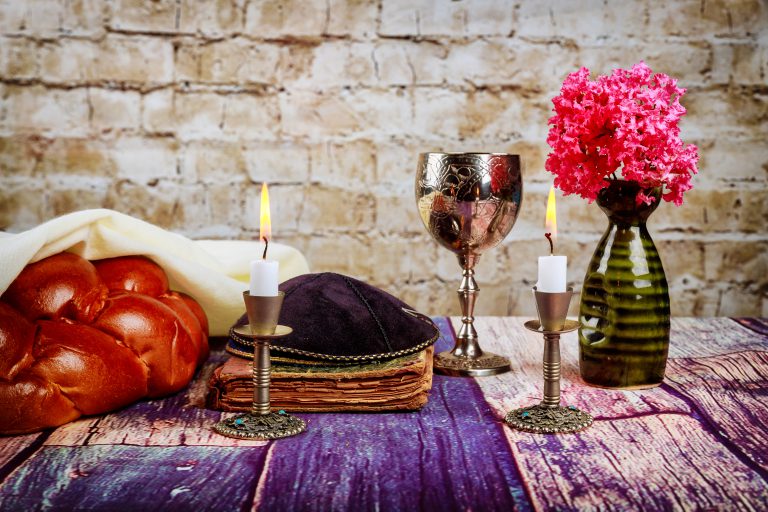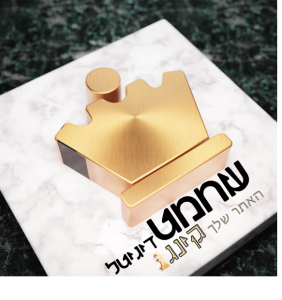Sukkat Shalom=Sukkah of Peace
“Sukkah of Peace“
Every Friday and Yom Tov night we recite: “… Hapores sukkat shalom aleinu v’al kol amo Yisroel V’al Yerushalyim – [God] spreads His canopy of peace (“sukkat shalom“) over us, over all His people Israel, and over Jerusalem” .The evening daily prayer service contains the line “Ufros aleinu succat shlomecha” (spread over us the sukkah of your peace). What is the connection between a sukkah and shalom? A sukkah is by definition a dirat arai – a temporary dwelling made usually of wood or a similar material, and covered on top with a thatched roof of leaves, branches and twigs that does not even keep out the rain.
A sukkah reminds us of the temporary huts (Succot) that the Children of Israel, passing through the desert for 40 years, would live in at night, pack up and transport during the next day’s travels as they walked towards the Promised Land. The Biblical injunction is that we should actually dwell in the sukkah for seven day; to quote Vayikra (Leviticus), Ch 23, v 42, “You shall live in huts (Succot) for seven days. I, the Lord, want to remind you that these were the huts (Succot) that the Children of Israel lived in during their journey through the wilderness”. The meaning is to literally move out of our homes into these temporary and frail shelters.
Why did the author of this prayer use this particular image, the sukkah of peace? What is the connection between an impermanent frail shelter, and shalom? Peace is one of the highest of all Jewish values, while the sukkah is a relatively common and ordinary dwelling. What does the sukkah have to do with shalom, with peace? The author of the prayer did not write “spread over us the stately mansion of peace” or “the majestic palace of your peace”, or “the magnificent fortress of peace”
or use more appropriate imagery to describe the state of peace. However, when you think about it, the more you realize that maybe the sukkah and shalom have great deal to do with each other, and that the author of this prayer was telling us something extremely profound.
![]() The sukkah as a temporary structure cannot without constant attention maintenance and repair endure for long. The same is true for peace. Even when peace already exists it must always be considered temporary and there is no guarantee that it will last, unless it is constantly maintained. There have been relatively few periods in history of tranquility. We erect structures of peace with care, but they are all too easily blown over by the strong winds of hatred, or undermined by the seeping waters of suspicion, or consumed by the fires of nationalistic self-righteousness. In order for the edifice of peace to stand intact, we have to be constantly on guard. We cannot take for granted that peace, once achieved, will automatically endure. It is a lesson learned all too bitterly in our time.
The sukkah as a temporary structure cannot without constant attention maintenance and repair endure for long. The same is true for peace. Even when peace already exists it must always be considered temporary and there is no guarantee that it will last, unless it is constantly maintained. There have been relatively few periods in history of tranquility. We erect structures of peace with care, but they are all too easily blown over by the strong winds of hatred, or undermined by the seeping waters of suspicion, or consumed by the fires of nationalistic self-righteousness. In order for the edifice of peace to stand intact, we have to be constantly on guard. We cannot take for granted that peace, once achieved, will automatically endure. It is a lesson learned all too bitterly in our time.
But this is not the only similarity between the sukkah and peace. A sukkah is entirely open and accessible. It does not cut off those inside from those outside. You can easily see into it and those who are in it can see easily see out. There have been those over the centuries who thought that the way to peace is through strong, impregnable borders which the enemy is unable to pass. It is the idea of Maginot Line; or Israel’s security fence or building castles and fortresses. A castle is built with strong, thick walls which separate the people inside from those outside. It does not have many windows. The few windows it does have are wide on the inside, but narrow on the outside. They were designed this way so that men could stand in them and shoot arrows outside while affording only the narrowest target to the enemy. These windows were not meant for looking through. You could barely see out, you could not see in at all. A mansion fortress or castle once built, will likely stand for hundreds of years. One can travel through the Land of Israel and see Crusader castles built almost 900 years ago, abandoned for 8oo years and yet they still stand, their walls intact .These fortresses and castles were built to keep people out
A sukkah, however, is totally different. It is open to all. Only in these circumstances can there be peace a fortress mansion or palaces aren’t suitable to be used as imagery to describe peace because they lack the essential quality of openess that is a prerequisite for peace and a symbol of peace.
To indicate the openness of the Sukkah we invite Ushpizin – seven spiritual guests, to our sukkah. These spirits visit us only if we also invite seven guests – poor, decent people, to sit at the table in our sukka, one person every day of the holiday.
Indeed, peace like the sukkah requires action, involvement, participation and constant care.
This, too, can be learnt from the sukkah. A sukkah is kosher for the holiday even if it lacks all the parts: a Sukkah with three sides, or even two plus a tefach is kosher. So peace is so precious and so essential, even if not available in its entirety, we should try to obtain peace partially, even in a fragmented form. Yes, sukkah and peace are intertwined, not by accident. Peace is often temporary as the sukkah and peace requires constant attention like the sukkah and Peace like the sukkah may be incomplete and yet there is virtue in it.
Another quality of a sukkah that seems to me to be relevant, is that in order to be valid, you must be able to look through the spaces in the roof and see the stars in heaven and to allow the heavens, as it were, to enter our own dwelling. In a sukkah we are not shut off symbolically as we would be in a palace or mansion by a protective ceiling from the One Above, and He is symbolically invited to enter our abode. A sukkah thus represents the connection between the lower and the upper worlds, the lifeline between man and God.
Sukkot is the time when we abandon our permanent homes and choose to live in a temporary dwelling for a full week. By so doing, we express our faith that our lives and our security do not depend on impregnable dwellings or fortresses. On the contrary, our lives and security depend on being truly connected with the One Above. Without that connection, even powerful ramparts and barricades cannot give us the peace we so fervently desire “Lo bechayil velo bekoach” – Not by might nor by strength but by My spirit,” says the prophet Zechariah (4:6).
These then are the things that sukkah teaches us about peace: that it is vulnerable and easily destroyed so that it demands our constant vigilance, that it must be based not on barriers between people but on openness and access, that it may be incomplete and that we must reach for the heavens to look to God for his protection.


 שחמט דיגיטל
שחמט דיגיטל